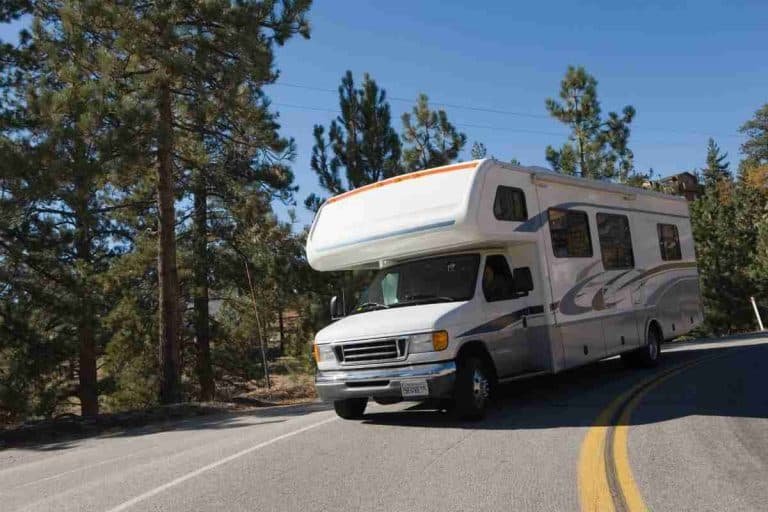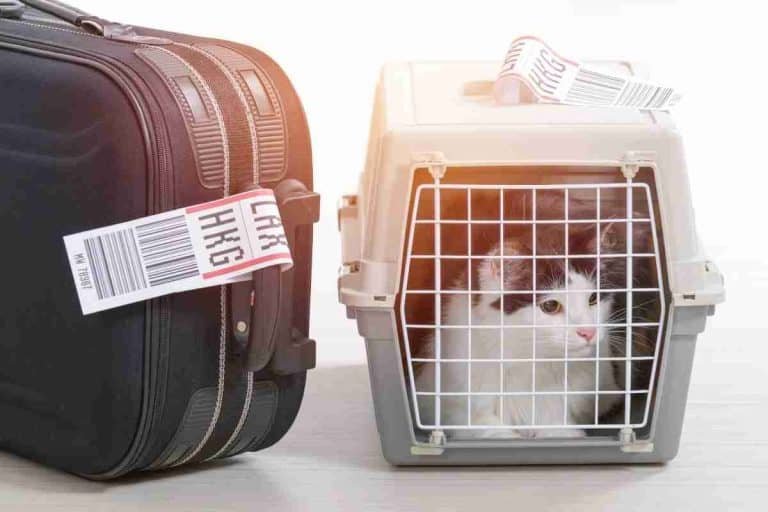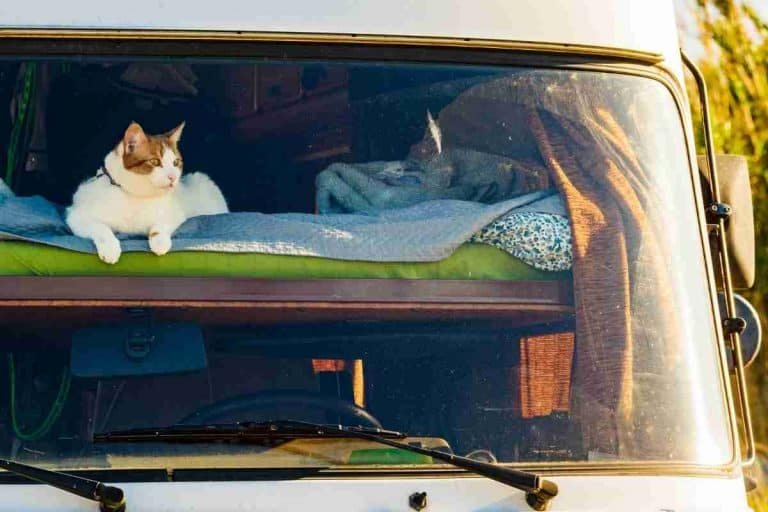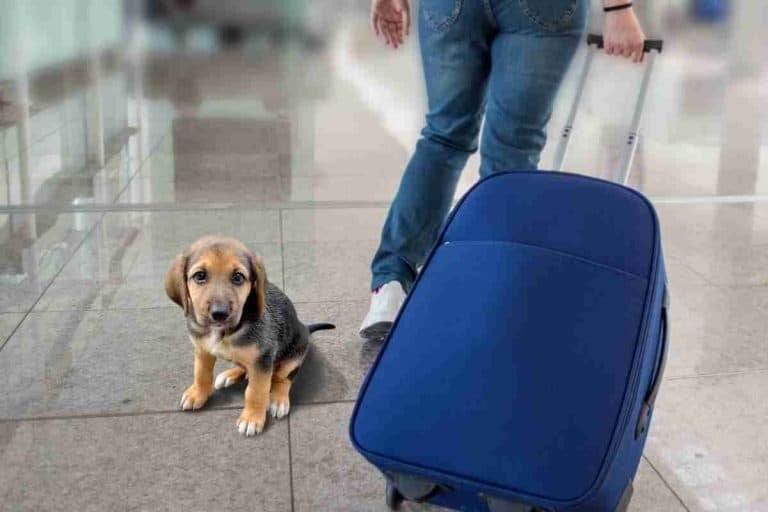How to Fly with Two Cats on a Plane: Rules, Packing & Day‑of Checklist
Affiliate Disclaimer: As an affiliate, we may earn a small commission when you make a purchase from any of the links on this page at no additional cost to you!
Last Updated on October 12, 2025
Flying with two cats doesn’t have to be guesswork. Airlines treat cats as carry‑ons and enforce fees, per‑passenger pet limits, and under‑seat carrier sizes. Policies differ on whether two cats in one carrier are allowed. Age, weight, breed, and destination rules also apply. How to Fly with Two Cats on a Plane: Rules, Packing & Day‑of Checklist explains these requirements and helps owners prevent last‑minute refusals.
Readers will learn how to choose in‑cabin vs cargo, secure health certificates, and reserve pet space early. It covers carrier selection, pet fees, seat strategy, and TSA screening steps. Expect packing tips for litter solutions, liners, bowls, harnesses, and IDs. A concise day‑of checklist ties it together, reducing stress and keeping both cats comfortable from curb to cabin.
Who can fly with two cats and how airlines treat them
Airlines usually allow passengers to travel with two cats, but approval depends on the carrier’s policy, the cats’ size and health, and available under-seat space. Pet owners must follow airline rules that classify pets as carry-on items. Staff treat pets as ticketed occupants: expect a fee per animal, limits on how many pets a single passenger may bring, and the requirement to declare pets when booking.
Most major carriers require that pets remain in approved carriers under the seat for the entire flight. Staff will check carrier dimensions at the gate. Some airlines permit two small, well-bonded cats in a single carrier if both fit comfortably and the carrier meets size rules. Others insist on one carrier per cat. Because space is limited, airlines recommend booking early and confirming pet reservations with an agent.
Airlines that allow cats in cabin lists common carrier policies and can help owners compare rules. Owners should call the airline to confirm fees, cabin availability, and any necessary paperwork before purchasing tickets.
CTA: Contact the airline after booking to reserve pet space and verify carrier requirements.
In-cabin vs. cargo — pros, cons and safety implications
Choosing in-cabin or cargo travel affects safety, stress levels and logistics. In-cabin travel keeps cats with their owner, allowing monitoring and quicker intervention for distress. The cabin is temperature-controlled and pressurized, which reduces risk. Small or anxious cats benefit most from in-cabin travel.
Cargo travel suits larger cats or routes that prohibit pets in cabin. Cargo exposes animals to more handling, variable temperatures, and noise. Although many airlines use climate-controlled cargo holds, the risk to brachycephalic or medically fragile cats increases. Airlines sometimes prohibit certain breeds from cargo on hot days.
Regulators and animal-welfare groups recommend avoiding cargo when possible. When cargo is necessary, choose nonstop flights, book early-morning departures, and use an airline experienced with live-animal handling. Review the carrier’s live-animal policies and ask about climate control and handling procedures.
Airlines that allow dogs in the cargo can help owners evaluate which carriers operate cargo services and what safety measures they publish.
Rules for two cats in one carrier vs. two carriers
Airlines vary on whether two cats may share one carrier. Common acceptance criteria include both cats fitting comfortably, having room to stand and turn, and demonstrating a calm temperament when confined together. Bonded pairs and littermates often qualify, but staff may refuse if animals show stress or aggression during gate checks.
If an airline requires separate carriers, passengers must ensure each carrier meets size and ventilation standards and fits under the seat. Soft-sided carriers usually compress slightly to fit under seats. Hard carriers may offer more protection but often exceed under-seat limits.
Practical steps: measure carriers with a tape measure, practice short rides together, and include familiar bedding and a worn T-shirt for scent. Label carriers with contact details and veterinary records. At security, cats must remain in carriers unless authorities instruct otherwise.
How to secure a cat carrier in car offers tips on stabilizing carriers and keeping pets comfortable during transit, which also applies to airport transfers and gate-hold situations.
Common airline limits (age, weight, breed and destination restrictions)
Airlines set clear limits for pet travel. Minimum-age rules often require kittens to be at least 8 to 12 weeks old and fully weaned. Many carriers require current vaccinations and a recent health certificate, typically within 10 days for international travel and up to 30 days for some domestic flights.
Weight and size limits determine whether a cat can travel in-cabin. Airlines specify carrier plus cat maximums and under-seat dimensions. If a cat exceeds limits, cargo or specialized animal-shipping services become necessary.
Breed restrictions commonly affect brachycephalic (short-nosed) cats and dogs. Some airlines refuse certain breeds from cargo due to breathing risks in flight. International destinations add another layer: quarantine rules, import permits and country-specific vaccines can block travel or require weeks of preparation.
Airlines that allow snub-nosed dogs outlines how carriers handle flat-faced breeds, which parallels rules for brachycephalic cats. Owners must check destination requirements and obtain any required certificates well before travel.
Veterinary requirements and essential paperwork
Flying with two cats requires more than airline approval. Owners must assemble health certificates, vaccination records, and identification before booking. Most airlines and borders demand a USDA- or government-endorsed health certificate issued by a licensed veterinarian. Carry multiple printed copies and secure digital scans on a phone or cloud storage.
Essential items include a signed health certificate, up-to-date rabies record, proof of microchip or ID tag, and any required import permits. Attach each cat’s name and owner contact information to its carrier. Add destination-specific documents, such as a pet passport or parasite treatment receipt, when applicable.
Behavior and handling paperwork also helps. For cats prone to stress, documentation about prior travel or calming methods can speed gate checks. For practical tips on calming a nervous cat before and during travel, see how to travel with a fussy feline. Schedule veterinary visits early to allow time for vaccinations, paperwork, and any endorsements. Owners should confirm each document’s acceptable timeframe with the airline and destination authority well before departure.
Health exams, vaccination certificates and timing
Schedule the veterinary exam based on both airline and destination requirements. Many domestic carriers accept a health certificate issued within 10 days of travel. International travel often requires a certificate within 7 to 30 days, depending on the country. Confirm specific timelines with the airline and the destination’s agriculture or border agency.
Rabies vaccination usually must be current. Some countries require vaccination at least 21 days before arrival. Keep the vaccine lot number, date, and veterinarian signature on file. If a rabies titer test is necessary, allow several weeks for testing and processing.
Request the certificate to include the cat’s microchip number, weight, and a clear statement of fitness to fly. Have the veterinarian record recent parasite treatments and any required tapeworm or tick treatments, with dates and products used. Carry both originals and color copies of every medical document. A single missing or expired certificate can delay or block travel for both cats, so confirm timelines and book the vet appointment early.
International permits, microchip and country-specific rules
International travel introduces varied rules. Many countries require an ISO-compliant microchip (ISO 11784/11785). If a microchip does not meet that standard, a compatible reader or an additional microchip may be necessary. Register the microchip details in a searchable database and match the registration to travel paperwork.
Some destinations require a pet passport, a rabies serology (titer) test, or an official import permit. Others mandate parasite treatment within a narrow window before arrival. Embassies, consulates, or national agriculture agencies list these rules and often change them; check their sites regularly.
For shipments needing government endorsement, owners may need an additional step with agencies like USDA APHIS for an endorsed health certificate. Start international planning at least six to eight weeks ahead. Allow extra time for microchipping, titer testing, and any paperwork that requires postal processing or official stamps.
Service or support animal vs. regular pet — what documents differ
Documentation differs significantly between trained service animals and regular pets. A trained service animal that performs specific tasks for a person with a disability may qualify for exemptions and different handling rules. Airlines typically request proof of task training and current health documentation for service animals.
Emotional support animals no longer receive blanket travel exemptions on many carriers. Airlines often treat them as regular pets now. Owners should check the carrier’s current policy and prepare to purchase pet travel reservations if the animal does not meet service-animal criteria.
For service animals, gather identification, a detailed vaccination record, and any airline-required forms that attest to the animal’s training and behavior. For regular pets, present the standard health certificate, vaccination records, and import permits. When uncertainty exists, contact the airline in writing and request confirmation of accepted documents. Carry written approvals and printed forms on travel day to avoid last-minute refusals.
Choosing carriers and gear for traveling with two cats
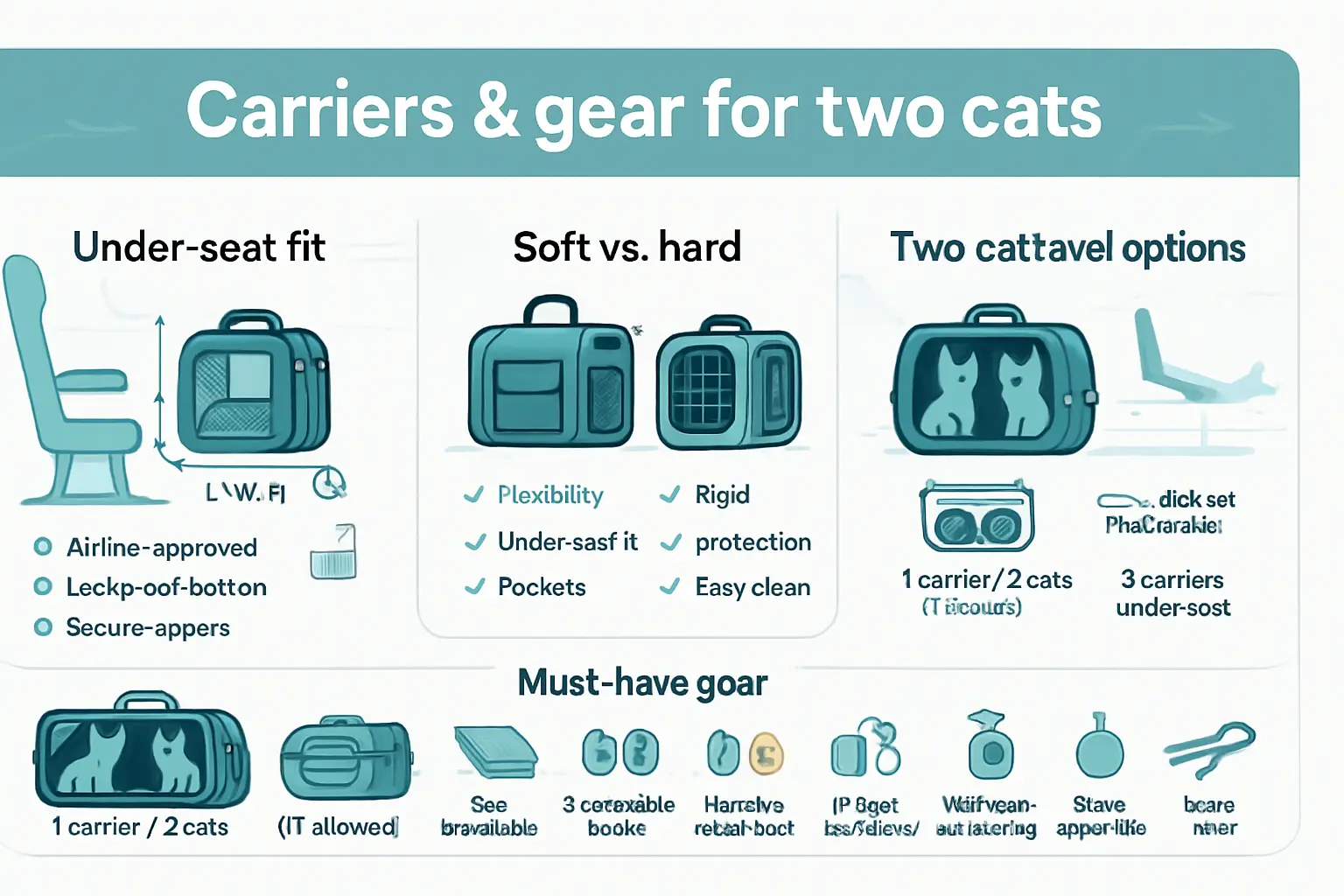
When planning How to Fly with Two Cats on a Plane: Rules, Packing & Day‑of Checklist, the gear choice starts with airline limits, cat temperament and trip length. Pick equipment that meets airline policies and reduces stress for both animals. Prioritize two properly sized carriers if the airline requires separate kennels. For short flights, compact carriers with good ventilation and secure closures work best. For longer flights, add padded liners and a lightweight blanket to create a familiar scent.
Consider backup items: an extra leash, duplicate ID tags, and a second collapsible water bowl. Secure carriers in transit and during ground travel; read a practical guide on how to secure a cat carrier in car for tips that apply to taxi or rental-car transfers. Confirm whether carriers count as one carry-on or two, and reserve spots early. Buying airline-approved carriers avoids surprises at the gate. Finally, choose gear that stacks well in overhead bins or stows under seats to keep the cabin tidy and the cats comfortable.
Carrier size, soft vs. hard, and fitting under the seat
Measure the airline’s maximum under-seat dimensions and compare them with the carrier’s external size. Measure a carrier with the door closed. For a correct fit, place the carrier under the seat at home to simulate the cabin space. Prefer carriers that allow the cat to stand, turn and lie down comfortably.
Soft-sided carriers compress for tight spaces and often meet under-seat rules more easily. They provide flexibility and extra pockets for documents. Hard-sided carriers offer rigid protection and easier cleaning, but they can fail to fit under low-clearance seats. For two cats, evaluate whether two soft carriers or one rigid double-compartment model fits the airline rules. Check lists of airlines that allow cats in cabin before purchasing. Look for carriers with leakproof bottoms, padded interiors and secure zippers. Test zippers and seams under gentle pressure to avoid in-flight escapes.
Criteria for two cats sharing a kennel and space-per-cat guidelines
Deciding if two cats can share one kennel depends on temperament, size and airline policy. Most carriers must allow each cat enough room to stand, turn and lie down independently. As a rule, avoid forcing two independent or anxious cats to share space. Bonded pairs that calmly groom and nap together tolerate sharing better than unfamiliar cats.
Check the airline’s rule on one or two pets per carrier. If an airline permits a shared kennel, ensure the carrier’s floor area and ventilation exceed the summed minimum space each cat needs. Provide separate resting spots inside the carrier using small pads or a dual-level insert to reduce competition. Observe cats in a trial run at home: place them together in the carrier for increasing intervals. Watch for signs of stress—hissing, flattened ears or pacing—and stop shared runs if aggression appears. For more handling and acclimation tips, see guidance on how to travel with a fussy feline.
Must-have accessories: litter solutions, liners, bowls, harnesses and ID
Pack a compact kit focused on sanitation, hydration and identification. Include a small, foldable litter tray or disposable puppy pads for short emergencies. Layer waterproof liners under absorbent pads to protect the carrier. Carry two collapsible bowls—one for water and one for food—and offer small sips during long waits.
Bring a lightweight harness and leash for airport walking and vet visits. Secure ID tags and a printed copy of vaccination records inside a clear folder. Add calming items like a fabric with a familiar scent and a few treats to distract cats without overfeeding. Keep wet wipes, trash bags, and extra zip ties for quick fixes. For guidance on bathroom logistics during flights and layovers, review information on how do cats go to the bathroom on a plane.
CTA: Buy a travel litter pan and extra liners before the trip to avoid last-minute hunting for odd-sized gear.
Training and prep so two cats tolerate the trip
The goal is predictable, low-stress behavior on travel day. Start planning at least six to eight weeks before departure. Schedule a veterinary check to confirm shots, obtain required paperwork, and discuss health risks for each cat. Choose airline-approved carriers sized to fit both cats if sharing, or two carriers sized to fit under the seat. Label carriers clearly with contact details and a copy of each cat’s vaccination record inside a plastic sleeve.
Build a routine that includes short daily carrier sessions, supervised practice car rides, and gradual exposure to airport-like stimuli such as crowd noise and rolling luggage. Rotate bedding and toys so carriers smell familiar. Maintain regular feeding times and avoid heavy meals within four hours of travel. Test each cat on a harness and leash for airport walks and bathroom breaks.
Record and monitor behavior during practice runs; adjust training pace if either cat shows signs of chronic stress. For practical carrier and calming techniques, see how to travel with a fussy feline. Confirm airline rules and book seats only after both cats tolerate extended carrier time.
How to acclimate each cat to the carrier and practice runs
Begin carrier acclimation in week one. Place the carrier in a common room with the door open. Put high-value treats, favorite toys, and soft bedding inside. Feed meals at the carrier entrance, then gradually move bowls deeper over several days. Keep sessions short and positive.
Progress to timed stays: 10 minutes, 30 minutes, then one hour. Practice closing the door briefly, increasing the duration each day. Take short car trips once the cat accepts the closed carrier. Start with five- to ten-minute drives, then extend to 30–60 minutes. Reward calm behavior immediately after exits.
Simulate airport conditions by introducing suitcase wheels, children’s sounds, and brief leash walks through a quiet terminal if possible. Use a carrier cover to reduce visual stimulation during transit. Install absorbent bedding and a secure water source for longer ride simulations. Train each cat individually so both tolerate confinement before pairing them. For tips on securing carriers in vehicles, consult how to secure a cat carrier in the car.
Introducing/co‑habituation steps if they’ll share a carrier
Only attempt co-habituation after each cat tolerates solo carrier time. Start with scent exchanges: swap bedding daily for one week. Place both cats near the closed carrier simultaneously but separated by a safe distance. Offer treats to both when they remain calm.
Introduce joint sessions in a larger carrier or travel crate. Keep sessions short at first—10 to 15 minutes—and reward relaxed postures. Gradually lengthen sessions and add mild movement, such as a slow, short car ride. Monitor body language closely: flattened ears, hissing, or repeated swatting require aborting the session.
If both cats accept close quarters, practice overnight co-sleeps in the carrier at home. Use pheromone spray on bedding to ease tension. Prepare a fallback plan: book two carriers or separate travel options if co-habituation stalls. For broader multi-cat travel strategies, see advice on traveling with cats in an RV, which covers confined-space introductions.
Non-sedation calming options and when to consult your vet
Non-sedation tools reduce anxiety without impairing reflexes. Use synthetic feline pheromone sprays or wipes inside carriers two hours before travel. Consider a calming wrap or vest designed for cats. Offer veterinarian-recommended supplements like L-theanine or casein-based chews, starting two weeks before travel to test tolerance. Play soothing music and maintain a predictable preflight routine.
Avoid herbs and human supplements without veterinary approval. Never give sedatives without explicit vet instructions; many airlines prohibit sedated animals. Consult a veterinarian immediately if a cat has respiratory problems, heart disease, severe motion sickness, or a history of aggressive stress responses. The vet can recommend safe prescription anxiolytics when necessary and advise alternate travel plans.
For practical calming tactics used specifically on flights, review 8 tips to stop a loud cat on a plane. Confirm any medication with the airline and request written clearance when required. If uncertainty remains, schedule a pre-trip vet visit at least two weeks before travel and adjust the plan accordingly.
Booking, fees and seat logistics for two cats
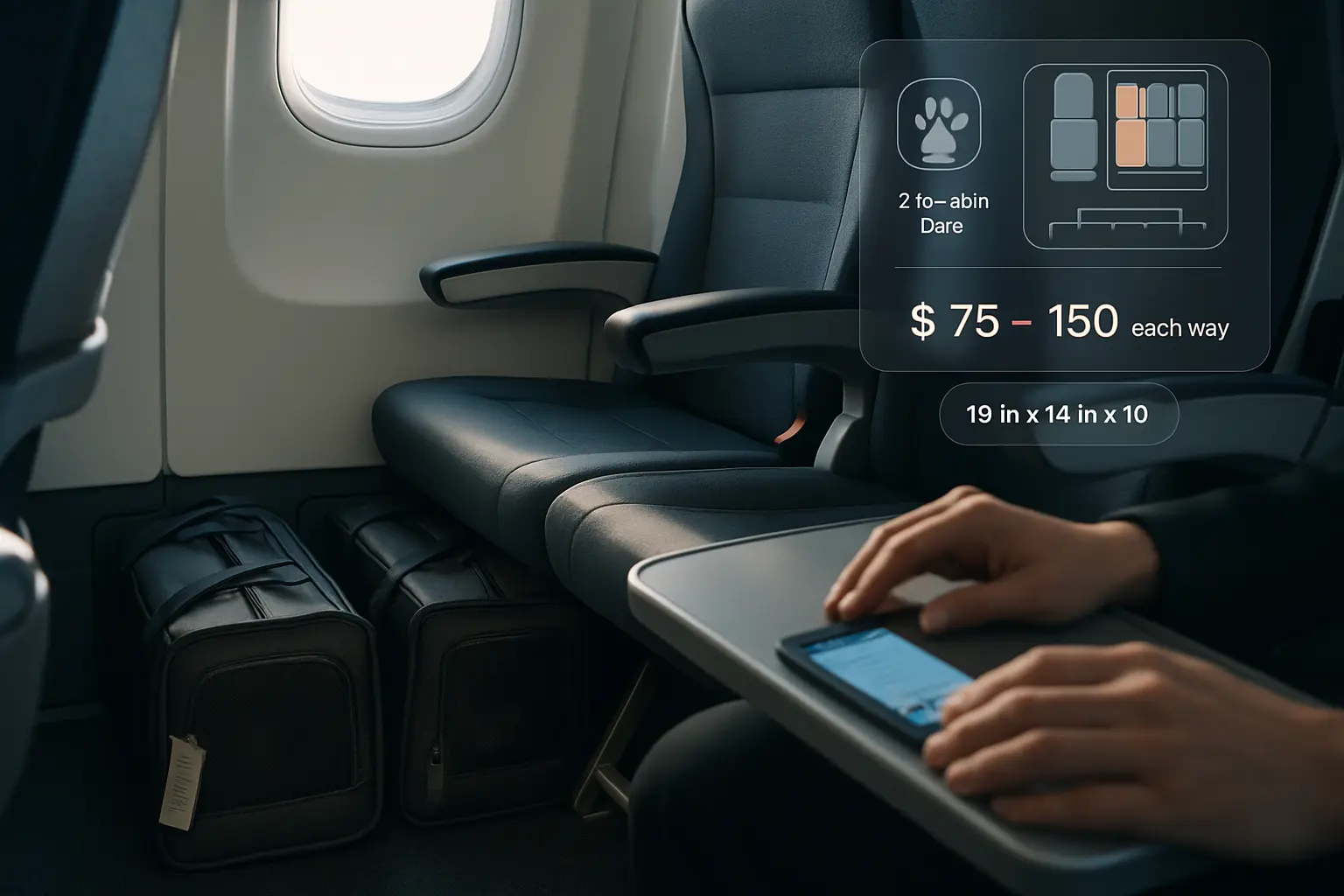
Reserving space for two cats takes planning. Airlines limit in-cabin pets per flight and enforce size, weight and carrier rules. Verify limits before paying for tickets. When rules conflict between booking systems and gate agents, the phone record wins. Keep paperwork, measurements and the pet reservation confirmation easily accessible for check-in and security.
How to reserve pets and tips for calling airlines
Call the airline’s dedicated pet desk as soon as the flight is chosen. Ask the agent to add both cats to the reservation and read back the pet reservation number. Request the carrier dimension limits and whether two cats can share one carrier under the seat. Note agent name, date and time of call. If the airline offers an online pet add-on, still confirm the addition by phone and save email confirmation. For a quick reference on carriers that accept cabin cats, review airlines that allow cats in cabin: airlines that allow cats in cabin.
Expected pet fees, extra-seat policies and cost-saving tips
Expect per-pet fees for in-cabin travel; common ranges are $75–$150 each way. Some carriers charge per carrier, not per animal, so two cats in one approved carrier can save money. Buying an extra seat for a carrier is allowed by a few airlines; this removes under-seat constraints but costs a full fare. Cost-saving tactics: book with airlines that waive fees for elite members, combine two small cats in a single carrier if rules allow, and choose nonstop flights to avoid repeat fees and transfers.
Seat selection, connecting flights and working with partner carriers
Choose adjacent window seats to keep carriers stable and reduce aisle traffic. Avoid bulkhead seats that may require stowing carriers in closets during taxi, takeoff and landing. For connections, confirm partner-carrier pet policies before booking; partner rules can differ and may require rechecking pets. Call partner airlines to confirm transfer procedures and minimum connection times. On the day of travel, reconfirm pet reservations 24–48 hours ahead to prevent last-minute surprises and ask the gate agent to note the pets on the passenger record as needed.
Step-by-step airport and in-flight checklist (day of travel)
Follow a tight, repeatable checklist on travel day to reduce stress for two cats. Arrive early—plan two hours for domestic flights and three for international. Keep carriers closed, labeled, and stacked if carrying two on one reservation. Keep paperwork, leashes, and a small treat bag in an easy-access pocket. Confirm seat assignment that allows both carriers to fit under the same row’s footwell. Pay any pet fees at check-in and get a gate receipt showing the carrier allowance.
Arrival, check-in and verifying paperwork at the counter
At the counter, present vaccination records and any required health certificate. The agent must verify carrier dimensions and the number of animals allowed in cabin. If the airline limits two pets per passenger, present proof of reservation for both cats. Ask the agent to note cabin-stow approval on the ticket record. Keep all documents in a clear folder and hand it to the agent only when requested to avoid fumbling.
TSA screening walkthrough and keeping cats secure
Expect to remove each cat from its carrier during TSA screening if asked. Have a harness and short leash ready so each cat remains secure. Place carriers on the conveyor belt empty; hold cats close and move briskly through the metal detector. If a cat resists, request a private screening room. Keep carriers covered with a breathable blanket to reduce noise and visual stimulation while the owner hands them to the screener.
Boarding, in‑flight care, feeding schedule and restroom planning
Board early to stow both carriers under the same row. Offer a small snack and water 1–2 hours before boarding; avoid heavy meals immediately before departure. During flight, check cats discreetly and keep them calm with a familiar towel or pheromone spray if previously vet‑approved. Never give sedatives without a veterinarian’s written consent. For restroom planning and how to manage elimination on a flight, see how do cats go to the bathroom on a plane. Pack extra absorbent pads, a small travel litter tray for long delays, and disposable bags for cleanup. Confirm one final time with gate staff that both carriers are cleared to remain in cabin before takeoff.
Troubleshooting, emergencies and safety considerations
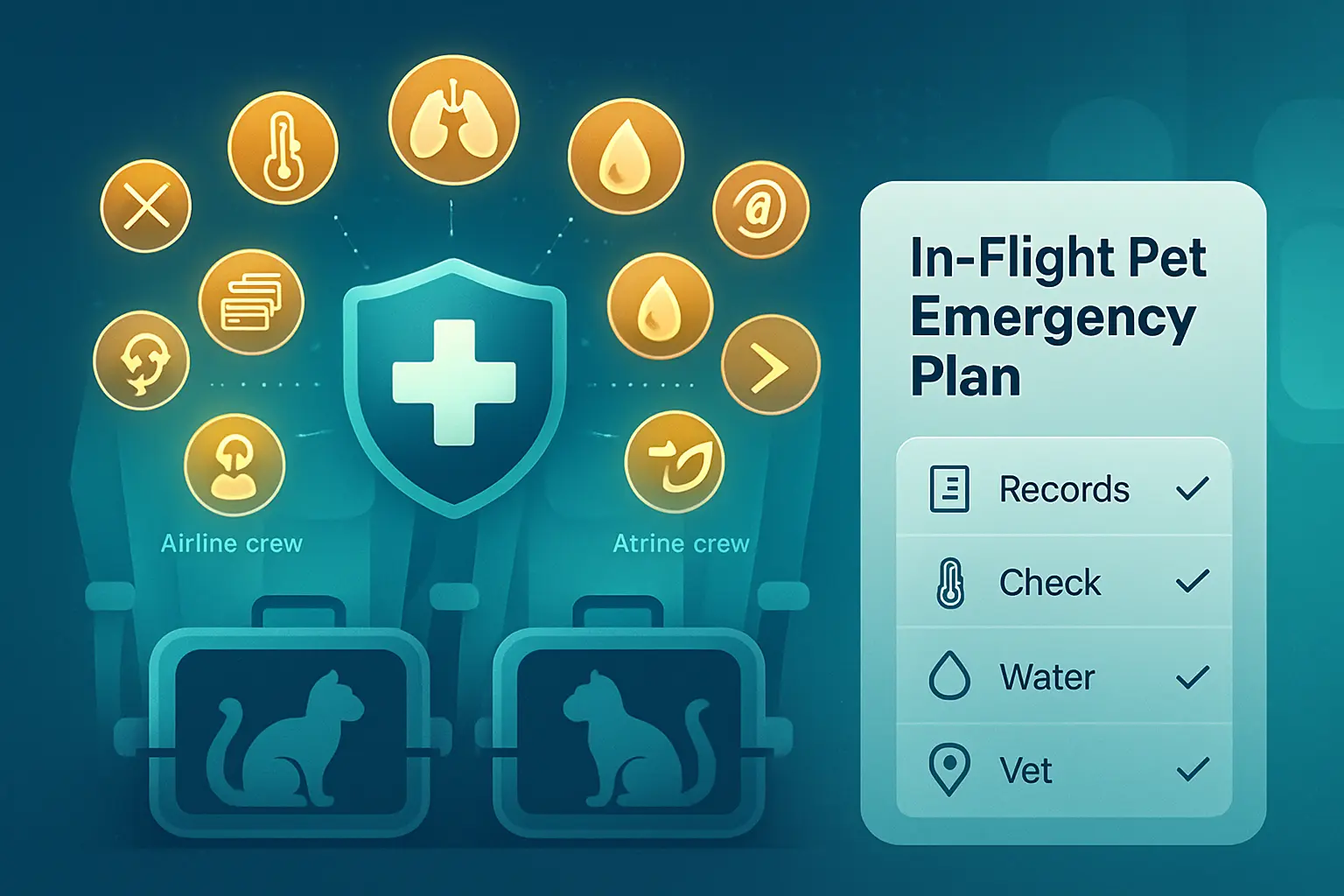
A clear plan reduces panic when something goes wrong. Confirm vaccine records, a health certificate, and microchip details before arrival. Pack a printed copy of the airline’s pet policy and emergency contact numbers for the airline and destination veterinarian.
Know common in-flight medical issues: heat stress, respiratory distress, and dehydration. Monitor breathing and color through carrier mesh. If a cat shows labored breathing or severe distress, alert flight staff immediately so they can free a bulkhead area or arrange priority care on landing.
Pressure changes can affect ears and sinuses. For related guidance about animal ear discomfort during flights, see does flying hurt dogs’ ears. That resource explains ear-pressure signs and simple mitigation steps useful for cats too.
Quick emergency checklist:
- Show records to crew and request help.
- Remove carrier cover briefly to check the pet if crew approves.
- Keep a small towel and collapsible water bowl ready.
- Call the destination vet before landing if symptoms persist.
CTA: before booking, confirm the airline’s emergency response for pets and secure direct flights when possible.
Managing stress, excessive meowing and motion sickness
Stress often causes loud vocalizing and nausea. Start with short carrier sessions at home to build positive associations. Use treats, toys, and familiar bedding so the carrier smells like home.
A pheromone spray or diffuser can reduce anxiety for many cats. Apply a small amount to bedding the night before travel. Avoid sedatives unless a veterinarian prescribes them; sedation can impair breathing at altitude.
For motion sickness, try withholding food four to six hours before travel but allow water. If motion sickness is severe, consult a vet about antiemetic medication and dosing certified safe for air travel.
On the day, place the carrier where the cat feels secure and cover it lightly to reduce visual stress. Offer a calm tone and slow movements during handling.
For additional calming techniques specific to feline travel behavior, see how to calm down a cat in the car.
What to do if cats fight, get loose or become ill mid-trip
Fights between cats escalate quickly in confined spaces. If two cats share a carrier and begin to fight, separate them immediately at the next safe opportunity. Never attempt to separate aggressively while the aircraft is moving; instead, ask crew to hold the cabin or open a space when safe.
Carry a spare, airline-approved carrier and a sturdy towel. If a cat gets loose inside the cabin, close nearby exit doors and gently herd the cat toward the spare carrier using treats or a soft voice. Avoid chasing; that increases panic and escape risk.
Illness steps: isolate the affected cat, keep it warm, and provide small sips of water if alert. Transport medical records to crew and request assistance from flight staff. Arrange for immediate veterinary care on landing if symptoms include difficulty breathing, bleeding, or collapse.
Prevent escapes by using harnesses and secure carrier latches. For prevention strategies used in other vehicle travel, consult how to keep cats from escaping RV.
Cargo-only scenarios: risks, safeguards and alternatives
Cargo holds expose pets to temperature swings, noise, and handling that increase risk. Airlines may route cargo through busy ramps or expose animals to delayed loading. Avoid cargo for brachycephalic breeds or cats with known health issues.
Safeguards when cargo is the only option:
- Use an IATA-compliant hard crate sized to allow the cat to stand and turn.
- Line the crate with absorbent pads and attach a water bottle or bowl that won’t spill.
- Label the crate with clear contact info and “Live Animal” stickers on all sides.
- Book nonstop flights and avoid extreme weather windows.
Alternatives include booking both cats in cabin if allowed, hiring a professional pet transport service, or choosing ground transport for shorter distances. Before committing to cargo, verify handling procedures and climate controls with the airline.
For perspective on airline cargo policies and options, see airlines that allow dogs in the cargo.
Fast FAQs and printable pre-flight checklist
The section gives fast, practical answers a traveler needs before booking flights with two cats. It focuses on airline rules, health paperwork, carrier choices, and last-minute steps.
Use the short answers below to decide whether to book a single-cabin trip or split the cats between passengers. For calming techniques and travel training that reduce on-board stress, the guide how to travel with a fussy feline offers behavior-focused tips that pair well with this checklist.
Keep this chapter saved on a phone and printed. The next two sub-sections break quick answers and a one-page checklist into actionable items. Travelers should confirm specific airline policies and local veterinary rules before arrival.
Quick answers: how many pets per passenger, sedation stance, costs
How many pets per passenger? Most U.S. and international airlines allow one or two small pets per passenger in cabin, but limits vary by carrier. Always check the airline’s pet policy and reserve spots early; available kennel spaces fill fast.
Can a vet sedate a cat for flight? Veterinarians generally advise against sedation for air travel. Sedatives can depress breathing and prevent cats from adjusting to cabin pressure changes. Airlines and vets recommend training, desensitization, and pheromone sprays instead.
Typical costs to expect: expect a per-cabin-pet fee between $75 and $200 each for domestic flights. International travel can add import/export paperwork fees, health certificates, and quarantine costs. Budget for carrier upgrades, vet visits, and any required vaccines.
Before purchase or booking, confirm seat availability for pet carriers and the airline’s allowed carrier dimensions to avoid surprises. For a quick overview of which carriers commonly accept cats in cabin, see airlines that allow cats in cabin.
One-page pre-flight checklist you can use at home and at the airport
Print this checklist and place it with travel papers. Check each box as tasks complete.
- Reservations: Confirm pet reservations and seat assignment; verify max pets onboard.
- Carrier: Airline-approved soft or hard carrier that fits under seat; test fit in car and home. Secure carrier inside vehicle during transit—see how to secure a cat carrier in car.
- Health & paperwork: Current vaccination records, health certificate if required, microchip info, and any international forms.
- Day-before: Feed a small meal 4–6 hours before travel; offer water. Practice a short carrier session with treats.
- Day-of timing: Arrive 90–120 minutes early for domestic; follow airline check-in window for pets.
- Carry-on items: Leash/harness, collapsible water bowl, extra absorbent pad, waste bags, calming pheromone spray, a small familiar blanket or toy.
- At security: Remove cat from carrier and hold securely or place in harness; carrier goes through X-ray.
- Onboard: Keep carrier under seat, avoid opening it during taxi, and check comfort discreetly during quiet moments.
CTA: Print this checklist now and store it with travel documents for a smoother airport experience.
Summary
This guide walks travelers through flying with two cats from start to finish: confirming airline rules, choosing in-cabin vs. cargo, deciding on one shared carrier or two, assembling veterinary paperwork, and selecting gear that fits under-seat limits. It also covers training, booking strategies, and a practical day-of checklist to keep both cats secure and comfortable.
The core message is simple: plan early, verify every rule directly with the airline, and prepare the cats through gradual acclimation. With the right carriers, documents, and a repeatable routine, most bonded pairs or two well-prepped cats can fly safely and with less stress.
Key Takeaways
- Confirm airline policies early: Reserve pet space by phone, verify whether two cats can share one carrier, and note fees (often per pet or per carrier).
- Prioritize in-cabin when possible: It’s safer and less stressful; use cargo only when required and follow IATA crate and nonstop/temperature safeguards.
- Paperwork is critical: Health certificate timing, current rabies proof, microchip/ID, and any import permits must match airline and destination rules; carry originals and copies.
- Right carrier and gear: Measure under-seat limits, favor soft-sided carriers for fit, label clearly, and pack pads, a compact litter solution, bowls, harnesses, and spare ID tags.
- Train for calm travel: Acclimate each cat to the carrier, run practice drives, use non-sedation calming tools, and consult a veterinarian for individualized guidance.
- Day-of execution: Arrive early, follow TSA handling with harness/leash, board early to stow carriers, feed lightly before departure, and keep an emergency plan ready.
FAQ
- What determines if two cats can fly in one carrier? Airline policy, each cat’s size, and temperament decide approval. Both must stand, turn, and lie down comfortably, and staff may refuse if either shows stress at the gate.
- How much does it cost to fly with two cats? Expect $75–$200 each way per pet or per carrier, depending on the airline. A few carriers allow purchasing an extra seat; confirm fees and rules when reserving pet space.
- What paperwork do airlines commonly require? A recent health certificate, current rabies vaccination record, microchip/ID, and any import permits for international routes. Timelines vary, so confirm windows with both airline and destination authority.
- Why is sedation discouraged for flights? Sedatives can depress breathing and impair pressure adjustment at altitude. Most airlines and veterinarians favor training, pheromones, and vet-approved calming supplements instead.
- How should travelers handle TSA with two cats? Carriers go through X-ray while each cat is held or controlled with a harness/leash; request a private room if needed. Keep cats secured and move promptly through screening to minimize stress.


